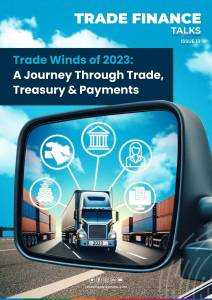Estimated reading time: 7 minutes
Key but under-utilised
One of the major challenges in credit insurance today is the industry’s ability to respond at the rapid speed that business now requires.
Although credit insurance is recognised as a key mechanism to support worldwide trade and trade finance, it is often seen as a long and complex process that is minimally digitalised.
This is a disappointing development, as many people would benefit from the use of credit insurance, regardless of the level of digitalisation. In fact, in a recent survey by the International Trade and Forfaiting Association (ITFA), 89% of respondents said that credit insurance is a major tool to support their trade finance operations.
Credit insurance is not currently being fully utilised to support the ecological transition. The absence of clear standards and guidelines for ESG (Environmental, Social, and Governance) reporting hampers the advancement of automation and digitalisation in this area.
Credit insurance hub
For credit insurance, the answer to the constantly increasing pace of business could lie in the standardisation and digitalisation of the industry, especially in the way people interact, e.g., through the development of a common exchange platform, or ‘credit insurance hub’.
Today, we look at what such a hub could look like, how it could benefit the industry, and the critical factors for success.
Currently, the credit insurance business is primarily conducted via email in a one-to-one model. Various stakeholders have to establish point-to-point specific communication channels and interactions because each insurer, bank, broker, or platform has their own specific behaviour and system.
With the ability to connect all stakeholders – policyholders, brokers, insurers, banks, and investors – a common platform would centralise and automate various operations, including placing, quoting, negotiating, and binding credit insurance. In an electronic format, this could facilitate faster collaboration between all parties.
Broker benefits
A common exchange would streamline the process of sourcing the right solution for each client, with the ability to quickly connect to several insurers through one access point.
With the potential for automatic matching according to criteria defined by each party, brokers could obtain the best coverage-to-price ratios and offer faster turnaround, enabling clients to act quickly as opportunities occur.
This would improve competition between insurers, ultimately giving banks and the insured access to more options, and supporting the development of products that are adapted for each client.

Insurer benefits
For insurers, a common exchange would provide a centralised distribution channel, giving them access to more brokers and clients.
With more liquidity and fluidity leading to an increase in overall volumes, all insurers would benefit. As the number of brokers using a common platform for a business-as-usual practice grows, insurers will rely on it to handle a greater proportion of their business.
With a simple integration directly into the insurer’s core system, they will be able to capture data in a standardised, structured way for better analysis and to scale their business without bottlenecks or delays.
This allows them to ensure a closer match to their risk appetites. Further, using real-time data, insurers could use the platform to automatically adjust quotes according to their capacity.
Streamlining operations between the various brokers and insurers would eventually benefit end-clients, offering greater visibility, better coverage solutions, and more reactivity – i.e., stronger support to their business through efficient and easy-to-use credit insurance.
A common exchange platform could also encourage greater participation from banks and investors in factoring or invoice discounting, thanks to greater visibility over whether an invoice is covered or not.
Currently, this is a critical stumbling block, and a deciding factor on whether to offer financing. With a platform that alleviates this issue, banks and investors would have a better way to de-risk their investment in invoices and receivables and greater certainty of the coverage provided by each insurer at a single-invoice level.
As the invoice financing ecosystem becomes more liquid, it will be increasingly attractive to investors and could extend to supply chain financing.
Further, a hub could ease and support ESG reporting. Centralising projects under a standard format would simplify ESG assessment and allow external providers to deliver standardised ratings and analyses directly onto the platform. This could be done once and shared with all stakeholders.
General benefits
For the industry overall, a common platform comes with the advantage of more willing participants, and the ability to reduce complexities and costs for all parties.
The industry also stands to benefit from deeper insights thanks to a richer central source of anonymised data with consistent parameters and processes.
Applying artificial intelligence to such a large source of standardised data could also give access to currently hidden information or trends, and possibly identify defaults or soon-to-default indications, or suspicion of fraud.

How can a hub be developed?
There have already been some initiatives, such as the Lloyd’s PPL which is specific to the London market and mostly focuses on the placing, or the Receivables Insurance Association of Canada (RIAC) which was too small to fund a viable solution on its own. Both examples make a strong argument for a global approach.
Currently, the cost of 1-1 connectivity exceeds the potential revenue and generates increasing technical complexity as experienced by some insurers or reinsurers that developed 1-1 API connections with their biggest customers.
This approach rapidly proved to be costly and not sustainable for smaller clients. Developing a common exchange would need to attract significant participation with a broad range of solutions so the model can be economically viable and ensure adequate volumes for each stakeholder.
Therefore, critical mass is key.
Once this is reached – and by spreading the cost across all stakeholders – a small fee of just a few dollars per policy could fund the solution for the longer term.
Another critical factor of success is through an “open network” approach. Prediction has always been a tough skill; betting your money on the first credit insurance hub and hoping it will become the primary choice is not in the industry’s DNA.
An open approach would support the emergence of the first initiative by giving early/founding members confidence in investing.
At the same time, it gives late joiners the liberty to join the initial hub or select independent initiatives that are interoperable with existing ones.
Ultimately, the objective is to build a common marketplace and avoid fragmentation, which would defeat the initial purpose.
Insurers must view the platform as a long-term investment, rather than a way to grow business quickly from the start.
Larger private insurers may initially be reluctant to join a hub due to the risk of increased competition, whereas smaller insurers may see the opportunity to secure a first-mover advantage.
Eventually, as more insurers, brokers, and insured join the hub, momentum will build and drive the entire industry to continuously improve through product innovation and technology, securing a viable long-term future for modern credit insurance.
What the industry needs is a first initiative with a good balance of global reach, significant players, and technology to initiate the move.
Tinubu has been at the heart of this industry for more than 20 years with proven experience in digitalisation and has a strong willingness to support such common platform initiatives.











































